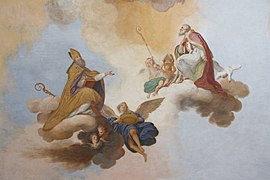
Ulrich of Augsburg
Ulrich of Augsburg (890 – 4 July 973), sometimes spelled Uodalric or Odalrici, was Prince-Bishop of Augsburg in the Holy Roman Empire. He was the first saint to be canonized not by a local authority but by the pope.[3]
Saint
Ulrich of Augsburg
890[1]
Kyburg, now Switzerland
4 July 973 (aged 82 or 83)
Augsburg, Holy Roman Empire
4 July 993 by Pope John XV
4 July
Bishop holding a fish; at dinner with Saint Wolfgang; rewarding a messenger with a goose leg, which turns into a fish on Friday morning; giving a garment to a beggar; with Saint Afra; riding through a river on horseback as his companion sinks; with a cross given him by an angel[2]
Against birth complications; against faintness; against fever; against mice and moles; diocese of Augsburg, Germany; happy death; weavers; San Dorligo della Valle
Life[edit]
Early years[edit]
Much of the information concerning Ulrich is derived from the Life of St Ulrich written by Gerhard of Augsburg sometime between 982 and 993. Ulrich was born in 890 at Kyburg in present-day canton of Zürich in Switzerland. He was the son of Hupald, Count of Dillingen (d. 909) and Dietpirch of Swabia (also known as Theoberga).[4] His maternal grandfather was Adalbert II the Illustrious, Count of Thurgau. His family was connected with the dukes of Alamannia and the Ottonian dynasty. An unnamed sister served as a nun in Buchau.
As was customary, his parents presented him as an oblate to the church while he was still a child.[5] A sickly child, at the age of seven he was sent to the monastery of St. Gall, where he proved to be an excellent scholar. While there, he became friends with Wiborada, a recluse who lived near the monastery and foretold that her young friend was destined to become a bishop.[1] He resolved to enter the priesthood, but was in doubt whether to enter the Benedictine Abbey of St. Gall or to become a secular priest. Sometime before April 910, he was sent for further training to a kinsman, Adalbero, Bishop of Augsburg, who made him chamberlain. Upon Adalbero's death (28 April 910) Ulrich returned home.[4] The Duke of Swabia presented him at the court of Henry I of Germany, where Ulrich became one of the household retainers.
Later life[edit]
Ulrich took part in the Diet held on 20 September 972, when he defended himself against the charge of nepotism in regard to his nephew Adalbero, whom he had appointed his coadjutor on account of his own illness and desire to retire to a Benedictine abbey.[12] Ulrich did, in fact, resign as prince-bishop and retired to Ottobeuren Abbey, where he became abbot.
As morning dawned on 4 July 973, Ulrich had ashes strewn on the ground in the shape of a cross; the cross sprinkled with holy water, and he was placed upon it. His nephew Richwin came with a message and greeting from the Emperor Otto II as the sun rose, and immediately upon this, while the clergy sang the Litany, Ulrich died. He was buried at the St. Afra church he had rebuilt in Augsburg; the burial was performed by Bishop Wolfgang of Regensburg. Later the St. Ulrich and Afra church was built in the same spot. He was succeeded by Bishop Henry.[13]
The maniple of Ulrich was woven in red and white silk using tablet weaving and Ulrich's relic was later analyzed by Peter Collingwood in his The Techniques of Tablet Weaving; Collingwood regarded it as a 'masterpiece'.[14]



